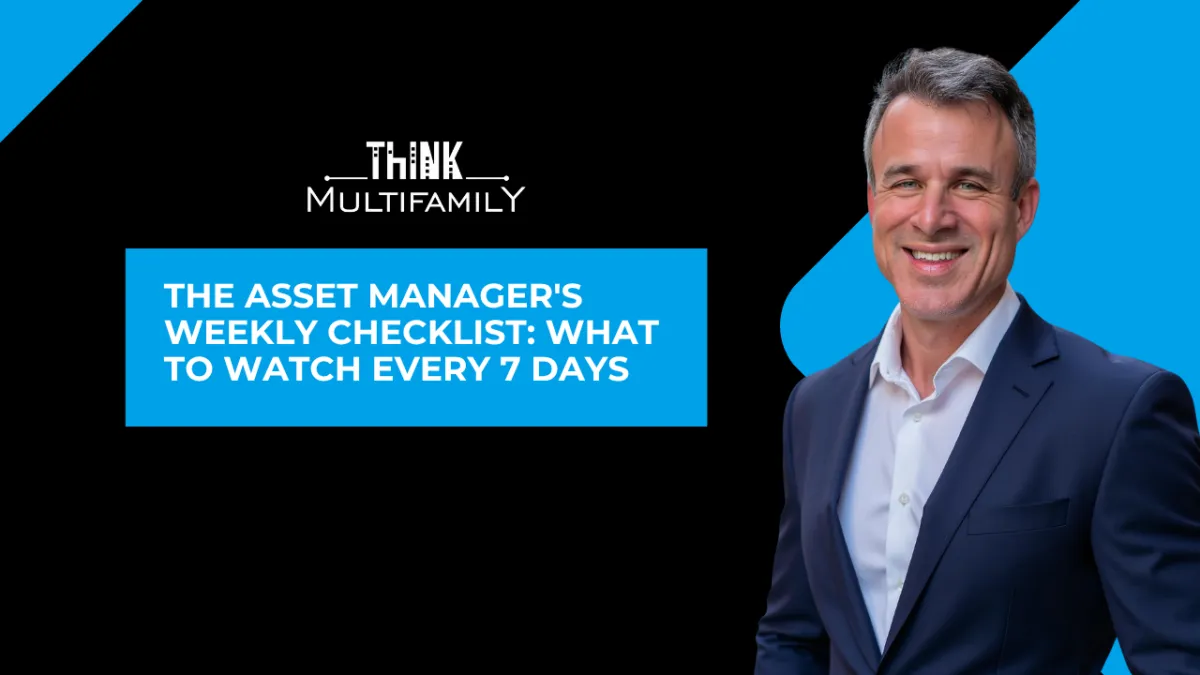
The Asset Manager's Weekly Checklist: What to Watch Every 7 Days
Think Multifamily | Mark Kenney
Multifamily properties don’t usually blow up overnight. They drift. Quietly. Slowly. And dangerously—when no one’s paying close attention.
It’s rarely one bad call or one tough month that sinks a deal. More often, it’s the slow fade that happens when asset managers assume instead of inspect.
That’s why seasoned operators run on a weekly rhythm. Not 12-hour workdays. Just consistent, intentional check-ins that keep deals on track, catch issues early, and remind your property manager you’re measuring execution—not just activity.
Here’s the weekly checklist we use at Think Multifamily to protect NOI, sharpen performance, and keep property management accountable.
1. Start with the Monday Morning Report (MMR)
🗂️ Why it matters: If your week kicks off without visibility into leasing, collections, and ops, you’re already playing catch-up.
The MOR should hit your inbox every Monday morning without chasing it down. Late? Missing info? That’s your first warning sign.
📌 What it should cover:
Occupancy (broken down by unit type)
Pre-leases + notice-to-vacates
Leasing traffic and showings
Work orders opened vs. closed
Move-ins and move-outs
Delinquency (by dollars and units)
If something looks vague or is missing altogether, follow up immediately. No excuses.
2. Compare Rent Roll to Delinquency
📉 Occupancy doesn’t pay the mortgage—collections do.
It’s easy to celebrate 95% occupancy, but if only 85% are paying, your NOI is already bleeding.
🔎 What to compare weekly:
Rent billed vs. rent collected
Delinquency by aging buckets (30, 60, 90+ days)
Economic vs. physical occupancy
High-balance tenants or eviction risks
Don’t just look at the snapshot. Watch the trends. Who’s always late? Is your PM truly addressing it—or just reporting it?
3. Stay on Top of Unit Turns
🏚️ Every day a rent-ready unit sits empty is money you’ll never get back.
If turns are dragging, overpriced, or rent-ready units aren’t listed quickly, your NOI is taking hits you might not even notice until later.
💬 Ask your PM directly:
“How many units are rent-ready today?”
“What’s our current average turn time?”
“Which units are delayed—and why?”
Cross-check with your CapEx tracker. Don’t take “vendor delays” at face value. Verify.
4. Review Maintenance & Open Work Orders
🧰 Deferred maintenance is the silent NOI killer.
It doesn’t always show up in the P&L right away, but it shows up in online reviews, higher turnover, and rising repair costs.
📋 Sort and review:
Longest-open service tickets
Most frequent issues (are they repeating?)
Units with multiple complaints
Vendor or staffing delays
Average ticket close time matters. Anything over 72 hours—especially habitability issues—needs an explanation.
5. Track CapEx & Renovations
🔨 Your value-add plan is the growth engine. But only if it’s moving forward.
Whether it’s unit interiors, exterior upgrades, or new amenities—you should know: How far along are we? How much have we spent? What’s the rent premium so far?
📈 Check weekly:
CapEx spent vs. budget
% of units completed
Rent premiums achieved vs. projected
Contractor delays, change orders, or cost creep
Behind schedule? Push for a recovery plan—not apologies.
6. Actually Read the Variance Report
📊 This is where issues hide in plain sight.
Variance reports aren’t just spreadsheets—they’re your early warning system. If you skim or accept vague notes, you’re missing the point.
🧠 Red flags to look for:
Expense spikes without cause
Staffing, repairs, or utility overruns
Copy-paste variance comments (“waiting,” “misc.”)
Push for real answers: Why did this happen? How are we fixing it? When will the numbers correct?
7. Talk to the PM—Numbers Aren’t Enough
👥 Reports matter, but relationships surface the real story.
A short weekly call might feel minor, but it’s where trust is built and problems often surface before they hit the spreadsheets.
✅ Ask on every call:
“Where are we off track this week?”
“What’s the biggest problem on-site right now?”
“Where do you need backup?”
“What’s going well we should double down on?”
Even when the numbers look good, staying engaged keeps execution sharp.
Bonus: Hidden Red Flags to Watch
Not everything shows up in reports. Keep your ear to the ground for:
Tenant reviews mentioning maintenance or safety issues
Vendors griping about slow payments
Sloppy curb appeal in online photos
Listings missing photos or details
If something feels off, dig in. Great asset managers don’t just review reports—they connect the dots.
Final Thought
You don’t need to grind out 12-hour days to be an effective asset manager. What you do need is consistency.
A simple weekly rhythm:
Catches problems early
Builds stronger communication
Creates accountability on-site
Multifamily is a performance business. Inspect what you expect—every week—and you’ll keep your deals on track.
Bottom Line: Great Deals Don’t Run on Autopilot
Don’t disappear after closing. Protect your investment with discipline and systems.
👉 Download our free guide: [The Guard Dog’s Guide to Asset Management] —the playbook for staying in control post-close.
Or… if you’re ready for real-time support, apply for Think Multifamily Coaching. Learn directly from operators who’ve managed hundreds of deals through good cycles and bad.
🚀 Apply for Coaching Today and run your investments like a pro.